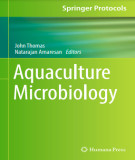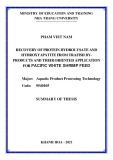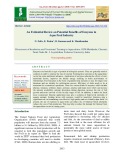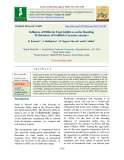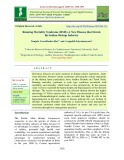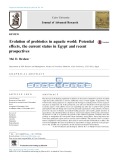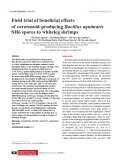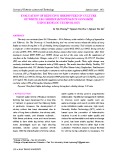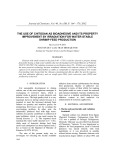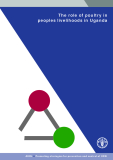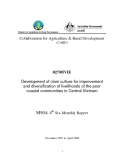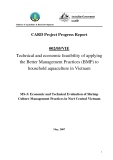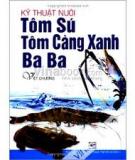
Feeding of shrimp
-
Part 2 book "Aquaculture microbiology" includes content: Characterization of probiotic properties of isolated bacteria; antibacterial activity of probiotic bacteria from aquaculture; preparation of marine algal (seaweed) extracts and quantification of phytocompounds; treating bacterial infections in fishes and shrimps using seaweed extracts; preparation and treatment of seaweed encapsulated pellet feed in fisheries aquaculture; treatment using seaweeds in fishes and shrimp by in vivo method;... and other contents.
 100p
100p  muasambanhan07
muasambanhan07
 20-02-2024
20-02-2024
 0
0
 0
0
 Download
Download
-
Objectives: To develop a process to recover value-added products, especially in FPH and HA, from catfish by-products; to investigate the use of an FPH and HA mixture for shrimp feed at the period of 20-55 days old.
 33p
33p  guitaracoustic09
guitaracoustic09
 14-01-2022
14-01-2022
 13
13
 1
1
 Download
Download
-
Enzymes are basically a type of protein in biological systems. They are generally used as catalysts in order to catalyse the rate of reaction. Feeding these enzymes in the aquaculture sector has some nutritional advances. Application of enzymes reducing the effects of antinutritional factors, improves the dietary energy resulting in better performance of fish/shrimps. Feed enzymes in the form of granules help enzymes to stay for longer time durations and are suitable for pelletisation process. Efficiency of feeds needs to be at maximum for economical operations.
 22p
22p  quenchua6
quenchua6
 15-06-2020
15-06-2020
 11
11
 2
2
 Download
Download
-
Astaxanthin is a xanthophyll carotenoid, which exhibits many important biological activities including a high degree of antioxidant capacity (AOC) and antibacterial activity, hence has a significant applicability in food, pharmaceutical and cosmetic industries.
 7p
7p  vijiraiya2711
vijiraiya2711
 27-05-2020
27-05-2020
 12
12
 1
1
 Download
Download
-
In the present study was investigated that, the influence of different feed additives viz., fish meal, shrimp head meal and soy flour on the breeding performance of goldfish. These three major ingredients were mixed in the feed at three different concentrations at 20, 30 and 40%. Totally, 15 numbers of goldfishes were stocked in 50 L capacity FRP tank for breeding. Every day the fishes were fed with 5% of the body weight.
 7p
7p  nguaconbaynhay5
nguaconbaynhay5
 11-05-2020
11-05-2020
 16
16
 1
1
 Download
Download
-
A 60 days feeding trial was performed to assess the potential use of shrimp head meal (SHM) as complete replacement of fish meal (FM) in commercial diets of Nile tilapia (Oreochromis niloticus) fry.Quadruple groups were fed each of five isonitrogenous (40%) diets were formulated to contain graded levels of SHM at 0% (control diet, T1), 25% (T2), 50% (T3), 75% (T4) and 100% (T5), respectively.
 9p
9p  angicungduoc4
angicungduoc4
 26-04-2020
26-04-2020
 9
9
 0
0
 Download
Download
-
Infectious diseases are quiet common in shrimp culture operations. Apart from infectious diseases certain syndromes affecting the culture operations in the shrimp farms particularly from Andhra Pradesh and Tamil Nadu. Running mortality syndrome is such type syndrome associated with morbidity and mortality which leads to less productivity. In the present study we have examined the haemolymph and hepatopacreas of the infected shrimps. The results revealed that, the affected shrimp showed the higher percentage of Vibrio species such as Vibrio parahaemolyticus and Vibrio azureus.
 7p
7p  nguaconbaynhay3
nguaconbaynhay3
 07-02-2020
07-02-2020
 13
13
 0
0
 Download
Download
-
The present study was carried out to understand the dietary ginger, garlic and fenugreek on growth performance on Litopenaeus vannamei L. Vannamei was fed with three different herbal powder of ginger, garlic and fenugreek of varying levels of 1%, 2.5%, 5%, 2%, 4%, 6%, 0.5%, 1% and 1.5% of concentrations respectively to assess the optimal growth promoting potential. The feeding trial was continued for 63 days with triplicates in each treatment. The growth parameters (ABW, weight gain, SGR), feed efficiency parameters (FCR) and survival rate were significantly (P ginger > fenugreek > control.
 9p
9p  cothumenhmong1
cothumenhmong1
 11-12-2019
11-12-2019
 18
18
 1
1
 Download
Download
-
The increase in the human population in addition to the massive demand for protein of animal origin forced the authorities to seek for additional sources of feed supplies. Aquaculture is the world worth coming expansion to compensate the shortage in animal protein. Feed in aquaculture plays an important role in the production cycle and exert threshold on both practical and economic aspects. Feed additive sectors are expanding day after day to achieve better growth and health for fish and shrimp and to meet the potential requirements of the culturists.
 27p
27p  trinhthamhodang1
trinhthamhodang1
 16-11-2019
16-11-2019
 36
36
 2
2
 Download
Download
-
This field study was performed to demonstrate that Bacillus aquimaris SH6 spores administered as a feed supplement in adequate amounts confer beneficial effects to the whiteleg shrimp. Shrimps were administered either B. aquimaris SH6 spores at 1×106 CFU g-1 pellet (SH6 group) or a mixture of SH6 and B. subtilis SH23 spores at 5×105 CFU g-1 pellet for each strain (SH6-SH23 group). After a 28-day feeding period, the number of SH6 spores in the gut of whiteleg shrimp in the SH6 group and the SH6-SH23 group were 5.7×103 CFU gut-1 and 7.7×103 CFU gut-1, respectively.
 6p
6p  caygaocaolon1
caygaocaolon1
 13-11-2019
13-11-2019
 7
7
 1
1
 Download
Download
-
This paper reviews the latest findings in larval feeding and digestion of decapod crustacean larvae. The live feeds and manufactured feeds are discussed in relation with the digestive capability of various decapod crustacean larvae.
 15p
15p  vitamix
vitamix
 19-02-2019
19-02-2019
 14
14
 0
0
 Download
Download
-
The study was conducted from 2013 December – 2014 February at the wetlab in College of Aquacultire and Fisheries, Can Tho University. A 2-month feeding trial was carried out to evaluate the ability of using biofloc to reduce shrimp feed in PL of whiteleg shrimp (Litopenaeus vannamei).
 9p
9p  vidanh27
vidanh27
 08-12-2018
08-12-2018
 42
42
 0
0
 Download
Download
-
Chitosan with small content in the feed (0.48 - 0.75%) could be selected to prepare shrimp feed-pellet having so high water-stability that met the Standard of Vietnam Ministry of Fisheries 28-TCN 102/1997. The radiation treatment at sterilization doses (20 - 30 kGy) was evaluated as the most practical technology because irradiated chitosan with reduced content of 0.34% has capacity to be prepared feed-pellets as stable as comparable to imported products.
 7p
7p  uocvong05
uocvong05
 09-10-2015
09-10-2015
 46
46
 2
2
 Download
Download
-
This Minor Field Study (MFS) was performed by Teresia Lindberg and Anna Nylander, who are both studying Eco-toxicology at Uppsala University in Sweden. The report is a Master´s thesis for Teresia Lindberg. The Swedish International Development Agency (Sida) finances a number of so-called Minor Field Studies for students or young people to carry out a research project in a developing country. The study usually takes place in one of Sida´s target countries and is part of a local Sida-sponsored aid programme.
 82p
82p  phongmt1993
phongmt1993
 09-08-2013
09-08-2013
 93
93
 12
12
 Download
Download
-
Each participant was presented with a workshop folder containing introductory material and printed versions of all power-point presentations. In addition each participant was given a CD containing PDF copies of all presentations, PDF copies of the National Research Council’s Nutrient Requirements of Fish (NRC 1993) and an FAO publication titled The Nutrition & Feeding of Farmed Fish & Shrimp (Ed. Albert G.J. Tacon 1987).
 55p
55p  loginnhanh
loginnhanh
 22-04-2013
22-04-2013
 57
57
 1
1
 Download
Download
-
The main objective of the project is to develop and expand clam technology (production of seeds and livestock) to sustain the livelihoods of poor farmers in coastal North Central Province and develop a management strategy contributes sustainable water use clam aquaculture farms to improve water use thai.Trong tomtrang six months, the focus of the project is focused in the following two aspects. (1) Prepare and create favorable conditions for the agreement between stakeholders and research organizations to carry out 'on farm trials.
 42p
42p  xau_la
xau_la
 10-02-2012
10-02-2012
 65
65
 11
11
 Download
Download
-
The purpose of the study was to analyze the current practice of shrimp farming in the north central Vietnam, to evaluate the status of agricultural production and economic conditions - social and environment, and determine the limit application of better management practices. The report presents the results of a survey of 90 shrimp farmers in north-central provinces of Vietnam (Ha Tinh, Nghe An and Thua Thien-Hue). Shrimp production costs mainly by feeding (average 65% of total cost) for different varieties of food between provinces.
 30p
30p  xau_la
xau_la
 10-02-2012
10-02-2012
 69
69
 8
8
 Download
Download
-
Tiger shrimp (P. monodon) and marine fishes are common fish cultured in coastal area of Vietnam. The study on nutrition for such species has not much when compared to freshwater fish species. Trash fish is the traditional feed for marine cultured fish and tiger shrimp in semi-intensive system. The supply is not stable in term of quality and quantity. Moreover, the price has increased. Therefore, finding alternative feed for trash fish is very important and crucial issues Using pellet feed in which fishmeal was replaced by plant protein that started in 90’s decade.
 12p
12p  quocnamdhnl
quocnamdhnl
 05-12-2010
05-12-2010
 132
132
 38
38
 Download
Download
-
Shrimp farming is an evolving sector of agriculture that creates important economic opportunities in many rural communities plagued by under and unemployment. This water farming practice relies on the wise and responsible use of coastal natural resources and habitats. The long-term, local success of shrimp farming is also influenced by global market forces, consumer preferences and international food safety standards. Advances depend on accessibility of critical research, educational and laboratory services.
 278p
278p  ttnhanag
ttnhanag
 29-09-2010
29-09-2010
 169
169
 61
61
 Download
Download
CHỦ ĐỀ BẠN MUỐN TÌM








